Small Campus, Big Opportunity at Penn State Shenango
SHARON, Pa. — The campus is small. It consists of a handful of buildings and has an enrollment that should come in at just more than 470 this fall semester.
No matter. Its name and credentials are big, as are the opportunities to the students who attend Penn State University’s Shenango Campus in Sharon, Pa., administrators and faculty say.
“A student can stay and get a Penn State education right here in the Shenango Valley,” says Jo Anne Carrick, campus director and chief academic officer. “We also contribute to the community in regard to an educated workforce.”
Carrick started her post-secondary education at the Shenango campus in nursing and worked in the field more than a decade at Sharon Regional Hospital. At the same time, she taught in the nursing program at the Shenango campus and in 2006, relocated to Erie, Pa., to oversee the nursing program at Penn State’s campus there.
When she returned in 2014 as director of Penn State Shenango, Carrick was taken aback at the closed storefronts in the city’s once bustling downtown. “It wasn’t the way I remembered it when I left,” she says.
Nearly four years later, the campus and downtown Sharon are more vibrant than ever, she observes. New shops have opened in the central business district. The campus increasingly draws attention as a launching pad for students looking for a solid base that could propel them to a four-year degree within the Penn State system.
“We provide students with a solid foundation as they transfer to University Park or another campus,” Carrick says. “We provide a world-class education for the residents of this community and beyond.”
 Jo Anne Carrick is the campus director of Penn State Shenango.
Jo Anne Carrick is the campus director of Penn State Shenango.
Students can earn two years of college credit at Penn State Shenango and then move on to Penn State’s main campus in State College, Pa., or one of the 16 other regional campuses, such as Erie.
Some programs, such as the campus’ long-term partnership with the Sharon Regional School of Nursing, Carrick says, have enabled Penn State Shenango students to complete a four-year degree in nursing.
The campus was established in 1965 when the Shenango Valley was still a thriving steel manufacturing center. As the mills closed, and population declined during the 1980s and 1990s, so did enrollment. But Penn State Shenango’s investments and upgrades throughout the last two decades successfully positioned it for growth today, Carrick says.
Business, health care, technology, mathematics, art, science – as well as the resurgence of an athletics program – are all hallmarks of a Penn State Shenango education, Carrick says.
“All campuses are part of the Penn State Athletics Conference,” she says. “In 2018, we’ll start with men’s basketball,” resurrecting an athletics program disbanded during the 1990s. “Athletics enrich the college experience, Carrick says, “and there’s pride in being a part of a Penn State program.”
Understanding the students who attend the campus is essential to Penn State Shenango’s success, says Chuck Greggs, director of admissions. “Most of them are living at home and working a part-time job so they don’t get too far into student debt,” he says.
To help offset the costs of a college education, Penn State Shenango has established a grant program available to those who enter the campus with a 3.0 GPA or higher, Greggs says.
Often, these students are ineligible for larger student grants and have to rely on student loans to cover the additional costs. With this in mind, students entering with a 3.0 or above are eligible for an annual $3,000 grant toward tuition.
Tuition and fees at Penn State Shenango are about $13,000 per year. Because the campus is a commuter school, room and board aren’t factors, so many students in the region find the tuition rate is well worth a Penn State education. “It’s a consumer market, and there’s a lot of competition between the Youngstown, Cleveland and Pittsburgh markets,” Greggs says.
What also sells the campus is the student experience, he continues. Among the more innovative programs the campus has launched is its “alternative spring break” initiative, when students get the opportunity to travel abroad or within the United States to work on development projects.
Since 2009, about 80 students have participated, traveling to countries such as Costa Rica, Peru and Belize to perform civic work in villages, Greggs says. Over the last two years, students went to Belize to work on a school there; they plan to return this spring.
“In Peru, we worked on building clean-burning stoves, because many people were cooking in open flames and breathing in carcinogens,” he says. “It’s a week of hard work. They live in a hostel or with a family. Probably the biggest challenge for them is no Wi-Fi for the week, but it’s a life-changing experience,” he remarks.
The goal is to give Penn State Shenango students a global education, says Jammie Clark, director of student services. “We start fundraisers in the summer and go all year,“ she says, while other aspects of the program are funded through grant programs and donations. International trips, she notes, costs a student about $800. “We have to make it affordable.”
New curricula in business administration have also pointed Penn State Shenango in different directions, says Lisa Bertin, assistant professor at the business school and the World Campus, Penn State’s online university.
With the collaboration of four other Penn State campuses in western Pennsylvania, Shenango helped launch a new major: project and supply chain management. “It’s similar to a business degree through the junior year,” she says. “Then it branches off in which each campus has a specialty that they share with the other four.”
Thus, students can earn a baccalaureate through a hybrid of classroom, video conferencing and online work toward a supply chain management major, Bertin says. “There’s a large amount of growth in this field,” she notes. One student has an internship at Wheatland Tube, while others have completed projects in other areas of business.
“When people think of project and supply chain management, they think of just manufacturing,” Bertin says. “It’s not. It’s also health care, retail, government. That’s what’s so neat about it.”
Copyright 2024 The Business Journal, Youngstown, Ohio.



